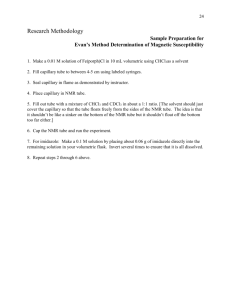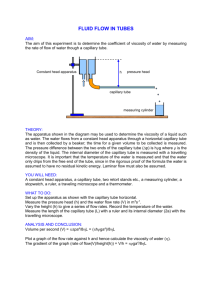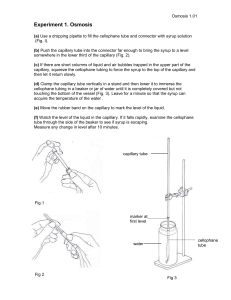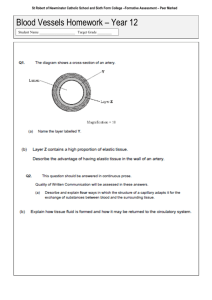AP Lab 06 - Organismal Respiration
advertisement
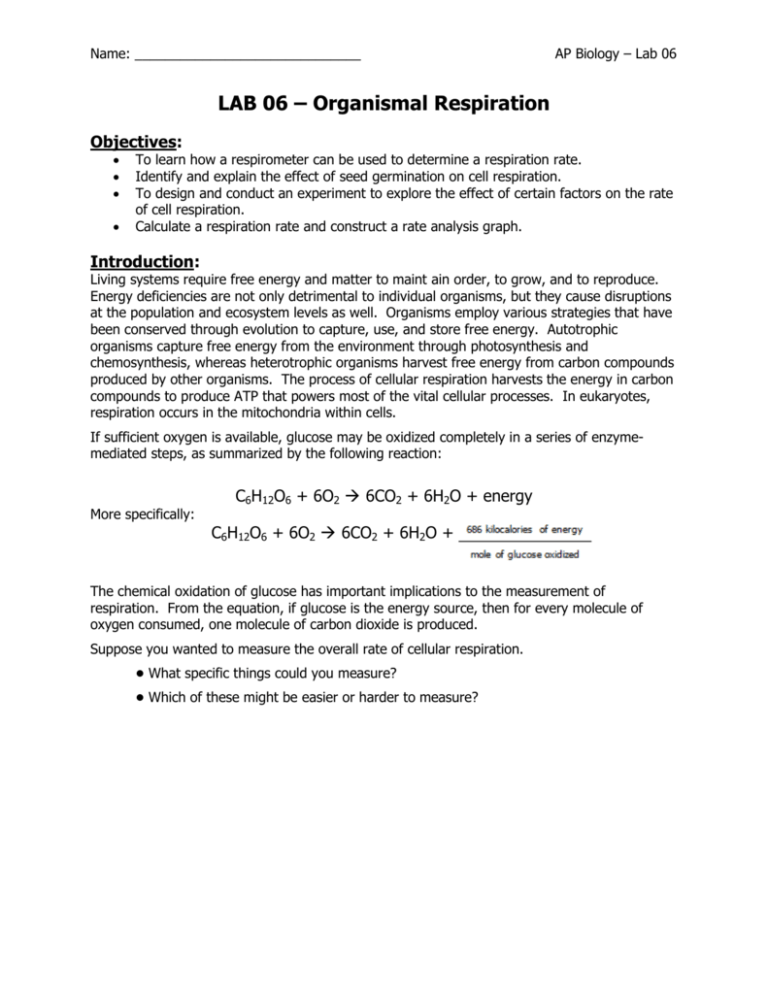
Name: ______________________________ AP Biology – Lab 06 LAB 06 – Organismal Respiration Objectives: To learn how a respirometer can be used to determine a respiration rate. Identify and explain the effect of seed germination on cell respiration. To design and conduct an experiment to explore the effect of certain factors on the rate of cell respiration. Calculate a respiration rate and construct a rate analysis graph. Introduction: Living systems require free energy and matter to maint ain order, to grow, and to reproduce. Energy deficiencies are not only detrimental to individual organisms, but they cause disruptions at the population and ecosystem levels as well. Organisms employ various strategies that have been conserved through evolution to capture, use, and store free energy. Autotrophic organisms capture free energy from the environment through photosynthesis and chemosynthesis, whereas heterotrophic organisms harvest free energy from carbon compounds produced by other organisms. The process of cellular respiration harvests the energy in carbon compounds to produce ATP that powers most of the vital cellular processes. In eukaryotes, respiration occurs in the mitochondria within cells. If sufficient oxygen is available, glucose may be oxidized completely in a series of enzymemediated steps, as summarized by the following reaction: More specifically: C6H12O6 + 6O2 6CO2 + 6H2O + energy C6H12O6 + 6O2 6CO2 + 6H2O + The chemical oxidation of glucose has important implications to the measurement of respiration. From the equation, if glucose is the energy source, then for every molecule of oxygen consumed, one molecule of carbon dioxide is produced. Suppose you wanted to measure the overall rate of cellular respiration. • What specific things could you measure? • Which of these might be easier or harder to measure? In the Procedure section, you will learn how to calculate the rate of cellular respiration by using a micro-respirometer. These measure relative volume (changes in pressure) as oxygen is consumed by germinating plant seeds. As oxygen gas is consumed during respiration, it is normally replaced by CO2 gas at a ratio of one molecule of CO2 for each molecule of O2. Thus, you would expect no change in gas volume to result from this experiment. However, in the following procedure the CO2 produced is removed by potassium hydroxide (KOH). KOH reacts with CO2 to form the solid potassium carbonate (K2CO3) through the following reaction: CO2 + 2KOH K2CO3 + H2O Thus, as O2 is consumed, the overall number of gas molecules in the respirometer decreases. This change, which then causes a change in volume due to the relatively constant pressure, can be used to determine the rate of cellular respiration. However, because respirometers are sensitive to changes in gas volume, they are also sensitive to changes in air pressure; thus, you need to use a control respirometer that will measure the environmental atmospheric pressure changes – without any living cells present. Since the CO2 is being removed, the change in the volume of gas in the respirometer will be directly related to the amount of oxygen consumed. A number of physical laws relating to gases are important to the understanding of how the respirometer works. The laws are summarized in the general gas law that states: PV = nRT Notice that this is not the Combined Gas Law that you used in Regents Chemistry, but the Ideal Gas Law. P is the pressure of the gas, V is the volume, n is the number of molecules of the gas, R is the gas constant, and T is the temperature. This law implies the following concepts: 1. If the temperature and pressure are kept constant, then the volume of the gas is directly proportional to the number of molecules of the gas. 2. If the temperature and volume remain constant, then the pressure of the gas changes in direct proportion to the number of molecules of gas present. 3. If the number of gas molecules and the temperature remain constant, then the pressure is inversely proportional to the volume. 4. If the temperature changes and the number of gas molecules is kept constant, then either the pressure or volume (or both) will change in direct proportion to the temperature. Several tutorials and animations are available online to help understand these concepts. A good chemistry review of the gas laws can be found at http://www.nclark.net/GasLaws. The investigation also provides an opportunity for you to apply and review concepts that you have studied previously, including the relationship between cell structure and function (mitochondria); enzymatic activity; strategies for capture, storage, and use of free energy; diffusion of gases across cell membranes; and the physical laws pertaining to the properties and behaviors of gases. It is also important to remember that gases and fluids flow from regions of high pressure to regions of low pressure. The amount of oxygen consumed will be measured over time. Page 2 of 9 Here are a few questions that you should consider and answer in your lab notebook before you start your prelab: 1. Why is it necessary to correct the readings of the respirometers containing the seeds (or other organisms) with the readings taken from the respirometers containing only glass beads? 2. What happens to the volume of the gas being measured (O2 consumption or CO2 production) when the temperature or pressure changes during the experiment? If pressure and temperature remain constant, will the volume of gas in the respirometers increase or decrease? Please explain. 3. Imagine that you are given 25 germinating pea seeds that have been placed in boiling water for five minutes. You place these seeds in a respirometer and collect data. Predict the rate of oxygen consumption (i.e., cellular respiration) for these seeds and explain your reasons. 4. Imagine that you are asked to measure the rate of respiration for a 25 g reptile and a 25 g mammal at 10°C. Predict how the results would compare, and justify your prediction. 5. Imagine that you are asked to repeat the reptile/mammal comparison of oxygen consumption, but at a temperature of 22°C. Predict how these results would differ from the measurements made at 10°C, and explain your prediction in terms of the metabolism of the animals. 6. What difficulties would there be if you used a living green plant in this investigation instead of germinating seeds? Page 3 of 9 Procedure: Measuring the rate of respiration is more technically challenging than many lab procedures because there are many places for potential error in the assembly and use of equipment. The advantages of the microrespirometer method as described by Richard E. Lee in American Biology Teacher include low cost, reliability, simplicity, and rapid response. However, for the sake of convenience, the procedure is outlined below. HINT: Read each step before doing it! You need to assemble two microrespirometers: one for measuring the rate of respiration in germinating seeds and the other for the control. Constructing a Microrespirometer 1. Plug in the hot glue gun and allow it to heat up. 2. Take a plastic syringe (any size for now – although I recommend using a 10 mL), and make sure that its plunger is pushed all the way in. 3. Carefully insert a 40 μL plastic capillary tube into the syringe where the needle normally would be. The capillary tube is 10 cm (100 mm) long. This means that every 10 mm to tube length equals 4 μL (1 mm equals 0.4 μL). Insert it as far as the plunger tip but no farther. This will help prevent the capillary from becoming plugged with glue. 4. While holding the capillary tube straight up, add a small amount of hot glue around its base (where it meets the syringe) to seal the capillary to the syringe. Keep the capillary pointed straight up until the glue cools – this should not take long. If needed, add a bit more glue to ensure an airtight seal between the capillary and syringe. (See Figure 1.) Figure 1: Adding hot glue to the base of the capillary tube. 5. After the glue has cooled, pull back on the plunger and make sure that the glue has not plugged the capillary. If the capillary is plugged, carefully remove the glue and capillary and start over. Page 4 of 9 Preparing the Microrespirometer 6. Draw a small quantity of manometer fluid (soapy water with red food coloring) into the full length of the microrespirometers capillary tube – NOT INTO THE SYRINGE BODY ITSELF! Then eject the fluid back out of the capillary tube. This coats the inside of the tube with a thin soapy film that helps prevent the manometer fluid from sticking. 7. Carefully insert a small plug of absorbent cotton into the barrel of the microrespirometers, all the way into the 0.0 mL (or cc) mark. You can pack this cotton to the end with the barrel of a clean 1.0 mL thin-stem pipette. (See Figure 2.) Figure 2: Inserting a cotton plug into the barrel of the constructed microrespirometer. 8. Add one small drop of 15% KOH to the cotton in the microrespirometers. Do not add too much! CAUTION: Make sure you are wearing gloves and safety goggles to protect your eyes because KOH is highly caustic. 9. Add a small plug of nonabsorbent cotton on top of the absorbent cotton plug already inside the barrel of the microrespirometers. You can pack the cotton to the end with the barrel of a clean 1.0 mL thin-stem pipette. (This nonabsorbent plug is needed to protect the seeds from the caustic KOH.) 10. Slowly reinsert the syringe plunger. CAUTION: Be sure to point the capillary tip into a sink or container. There may be excess KOH in the syringe that might squirt from the end of the capillary. Push the plunger in until it reaches the cotton so that any excess KOH is removed. 11. Remove the plunger to add seeds. 12. Take ~5 germinating seeds and figure out their volume by displacement using an appropriately sized graduated cylinder. Then add these seeds to the microrespirometers. Push the plunger in to the 5.0 mL mark. This creates a sealed microrespirometer chamber with a 5.0 mL volume. 13. Place three to four washers around the barrel of the microrespirometers. The washers provide weight so that the microrespirometers will sink. Page 5 of 9 Setting Up Your Control Respirometer Because a microrespirometer is sensitive to changes in gas volume, it is also sensitive to changes in temperature and air pressure. To compensate for any changes, you will use control microrespirometers. The control respirometer is set up just like the microrespirometer except that it contains nonliving matter (e.g., small glass beads or dry, baked seeds) instead of germinating seeds. 14. Add approximately the same volume of glass beads (determined by displacement) to the second microrespirometer you assembled. Reinsert the syringe plunger and push it to the 5.0 mL mark. This seals the chamber and creates a chamber that has the same volume as the experimental microrespirometer. 15. Place three to four washers around the barrel of the control. See the mock-up version sitting in the water bath by the teacher station. 16. Place the both assembled control microrespirometers side by side in the room temperature (~20°C) water bath. Adjust the level of the water bath so the capillary tube is sticking out of the water while the barrel of the control is completely submerged. In order to easily read the capillary tube, it must be out of the water. Make sure the top end of the capillary tube is open (not sealed). NOTE: The respirometers must be airtight, and they are sensitive to environmental changes, including bumping the lab table. Once the respirometers have reached equilibrium, they should not be touched or moved, nor should anything else be added to or taken out of the water baths (including your hands!). 17. Wait 5 minutes to allow the temperature in the microrespirometers to equalize. You must maintain the temperature of the water bath for the experiment. Collecting Data 18. Prepare a table like Table 1 to record your data and observations in your lab notebook. You will need multiple tables to record data for both the experimental and control microrespirometers. Below is just a guideline for the data tables... Table 1: Sample Data Table for Results Obtained Using Microrespirometers. Time (min) Total Distance Fluid Has Moved (mm) Change in Fluid Position During Time Interval (mm) Volume of O2 Consumed ( L)* 0 0.00 0.00 0.00 5 10 15 20 25 * make sure you add the appropriate column for the movement in the control respirometer to account for a “corrected” volume! Page 6 of 9 19. After the 5 minutes of equalization, use a dropping pipette to add one small drop of manometer fluid to the tip of each capillary tube. If everything is working properly, the drop will be sucked down into the capillary tube. The manometer fluid will seal the chamber of the microrespirometers. (You should use the plunger on the control microrespirometers to get the manometer fluid into the capillary. Pull on the plunger until the manometer drop is about halfway down the capillary. See Figure 3.) Figure 3: Demonstrating the addition of manometer fluid added to the end of a capillary tube. 20. As oxygen is consumed by cellular respiration, the manometer fluid plug will move toward the chamber. Record the starting position of each plug by marking its position in the capillary with a marker. Be sure to mark the bottom edge of the plug. These will be your time = 0 marks. Begin timing once you have made these marks. 21. At 5 minute intervals, mark the new position of the manometer fluid for each capillary tube. Be sure to mark the bottom edge of the fluid plug. Continue marking the positions until the fluid in the microrespirometers has traveled the entire length of the capillary, or until 25 minutes have passed. 22. At the end of 25 minutes, remove the microrespirometers from the water bath. Use a ruler to measure the distance from the initial mark (Time 0 mark) to each of the 5-minute intervals marked on each capillary tube. Record your measurements in the correct column of your data table. 23. Calculate the change in fluid position during each time interval. To do this, subtract the fluid position at the beginning of the time interval from the fluid position at the end of the time interval . Record your values. 24. Repeat the calculations for your control microrespirometer. 25. Using the values you obtained for the control microrespirometer, correct for any changes in volume that you measure that may be attributed to changes in temperature and air pressure. Figure 4 on the following page shows how the microrespirometer works. Page 7 of 9 Figure 4: Diagramming the key components of a microrespirometer. 26. Use the data you collected to determine respiration rate. Make sure you are using the correct units with your calculations. 27. Construct a graph to help visualize the data. Make sure the axes are correctly labeled with the correct units. Designing and Conducting your Own Investigation 28. You will now use the previous steps to conduct an investigation on what might affect the rate of respiration. You will need to establish a baseline, an environmental control (both of these are basically what we have already done), and a test(s) of some experimental factor that you and/or your group decide to investigate. This is wide open, so take some time thinking about what you would like to do. Make sure you fully answer the questions to the prelab to give you a good foundation for this investigation. Page 8 of 9 Hints For Your Lab Report: The Introduction section should have your hypotheses for both whatever you are investigating clearly written in the third part of this section. A visual – made via an Excel ‘drawing’ – showing the relative rates of the experimental group versus your baseline should be included. The Results section of your lab report will include: Open with the statement of your data. Rates should be stated. The calculations that were used to derive the rate can be shown in a cited Appendix section. If you are not sure about how to do this, please come talk to me. All data tables from YOUR investigation – not the data collected from the demo baseline and control runs. Your investigation’s tables should be complete... the example given in this lab is NOT the end all for what I expect. The graph of the corrected difference data. Remember, we are measuring the rate of oxygen consumption. Don’t forget the regression analysis line and its equation! Page 9 of 9
